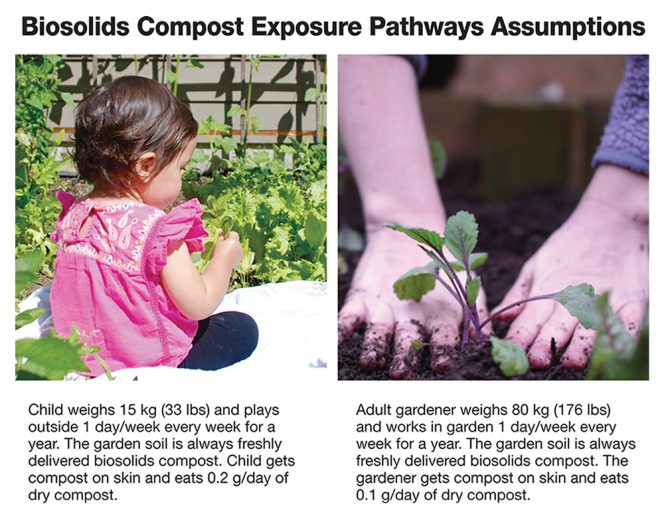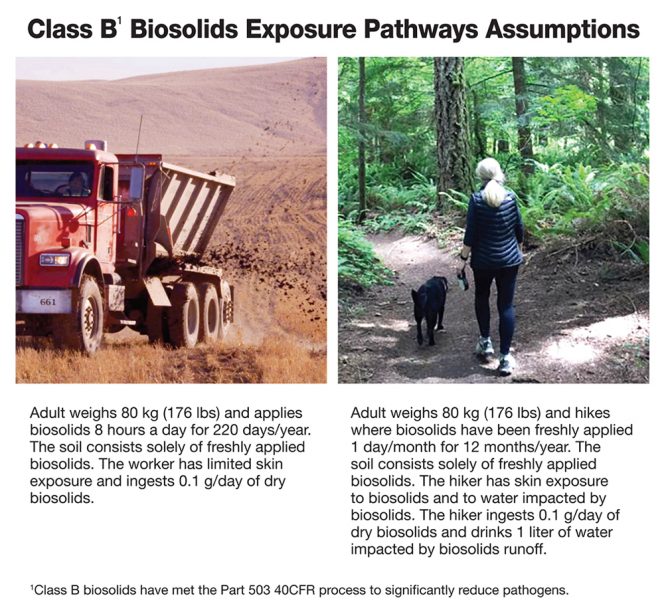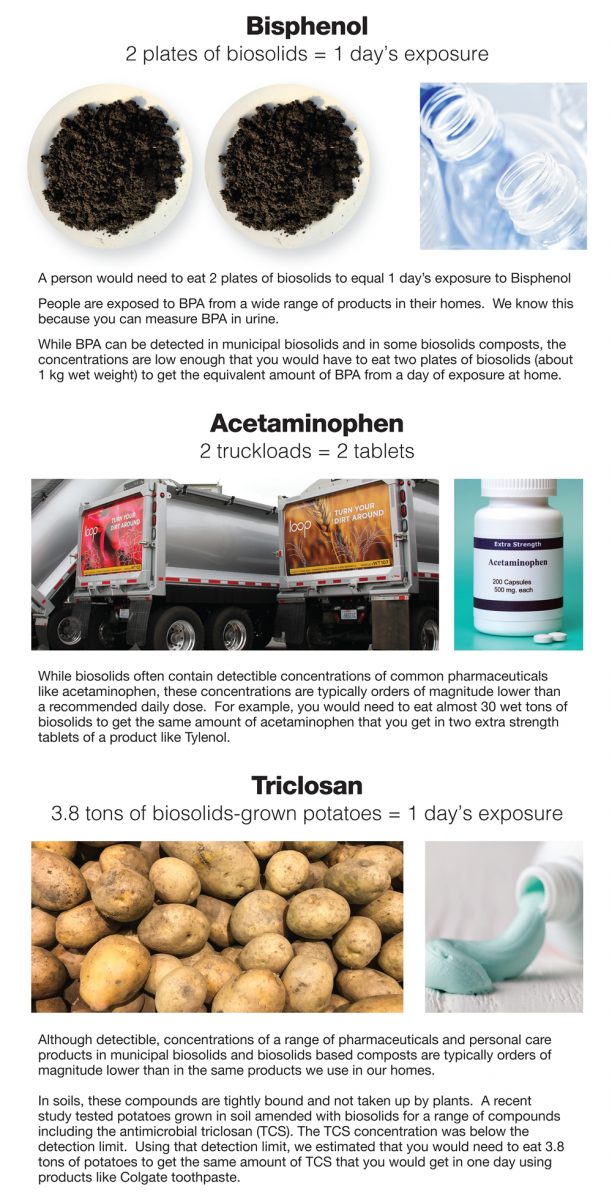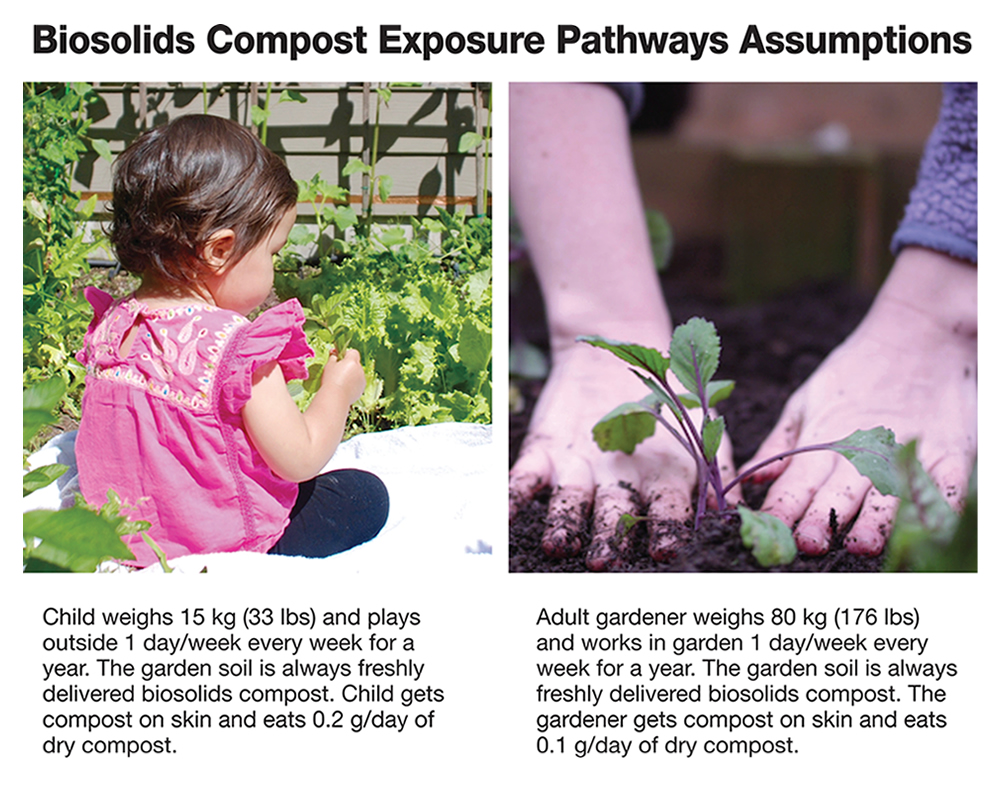Study examines how to relate concentrations of a select group of personal care and pharmaceutical products found in biosolids and biosolids composts to concentrations in these products for normal home use.
Sally Brown
BioCycle May/June 2019
These days, contaminants in biosolids, digestates and composts are more likely to come from peoples’ homes than from factories. Within those homes these contaminants are typically identified by their product names rather than their chemical names. Pharmaceuticals in your medicine cabinet make you better and are not seen as a threat to ecosystems. That all changes when these same compounds appear in soil amendments for use in the gardens that surround those homes or the farms that grow the food to feed the people who live in them. Antimicrobials in your toothpaste become triclosan in the soil. The pills that you rely on to keep your family small transform into 17-a ethinylestradiol. And the canned tomatoes turn into bisphenol A (BPA).
The general group of these compounds is referred to as pharmaceuticals and personal care products or PPCPs. And then there’s an entire other set of compounds being scrutinized these days that fall into the family of poly- and perfluorinated alkyls substances (PFAS). One example is Stain master carpet, a groundwater threat referred to as perfluorooctane sulfonate (PFOS) or perfluorooctanoic acid (PFOA). This article focuses on PPCPs.
Most of these PPCPs and PFAS compounds have been in our homes for decades. In fact, they are so common, and since so many of us have homes, they are also ubiquitous in the environment. For a long time, the presence of household chemicals in the environment fell below our analytical radar. Over the last few decades, however, we have also developed the ability to detect these compounds in exceedingly low concentrations. For most environmental scientists this presents a whole new field of study with a whole new set of toys (analytical instruments) to play with.
Scientific Exploration
The study of these compounds in the environment has followed a typical pathway for new fields of scientific exploration. Initial studies focused on determining concentrations of the compounds in waters, soils and wastes. Another round of research looked to identify pathways where these compounds could cause problems for the range of creatures exposed to waters and soils. For example, if BPA is found in the soil can it impact the environment by leaching to groundwater or being taken up into the edible portions of plant tissue? This is the same approach that was used for the EPA CFR Part 503 regulations that govern use of municipal biosolids. The limits set for metals in those regulations were determined after years of scientific studies and are commonly used for composts in addition to biosolids.
In certain cases, the scientists that do this work justify their research by using alarmist language to describe the potential threat of these compounds in the environment. Also, many use pure chemicals to do their work rather than chemicals as they actually occur in composts and biosolids. These compounds are all carbon based and typically bind tightly to organic matter, something that biosolids and composts have plenty of. In many cases, testing the compound as it comes in the composts will show lower availability and lower hazard than when the compound is added to the soil alone. When studies use pure chemicals instead of chemicals in biosolids or composts, risks are often exaggerated to the point where they have no bearing on real life.
Finally, in many cases, these compounds are tested at very high concentrations relative to what is typically found in the environment. This is not new; a similar approach was used to understand metals and toxic organics (PCBs and dioxins) availability in biosolids. This is done to establish a “proof of concept” or worst-case scenario.
 What is different today — versus, for example, when the Part 503 rules were developed — is that the research is happening as more and more municipalities are going above rather than below the radar with promoting and distributing soil amendments created from “waste” materials. Instead of biosolids traveling in anonymous trucks to distant farms, the trucks now bear the logos and brand names of the material inside. Many municipalities are developing products that can be used to make beautiful gardens for the people who help provide the feedstocks for their products. People who are interested in these trucks and these products are now asking whether these compounds in fact pose a risk. Sentences from studies are taken out of context and results are often improperly interpreted to suggest that there is a potential human health hazard. But the reality is that all of the compounds that people are worried about can be found in their homes — in their kitchens, living rooms and bathrooms.
What is different today — versus, for example, when the Part 503 rules were developed — is that the research is happening as more and more municipalities are going above rather than below the radar with promoting and distributing soil amendments created from “waste” materials. Instead of biosolids traveling in anonymous trucks to distant farms, the trucks now bear the logos and brand names of the material inside. Many municipalities are developing products that can be used to make beautiful gardens for the people who help provide the feedstocks for their products. People who are interested in these trucks and these products are now asking whether these compounds in fact pose a risk. Sentences from studies are taken out of context and results are often improperly interpreted to suggest that there is a potential human health hazard. But the reality is that all of the compounds that people are worried about can be found in their homes — in their kitchens, living rooms and bathrooms.
In addition, the numbers that are reported are difficult to understand. Even with a scientific background, it is hard to put a number like 89 µg kg-1 into a real-world context. What most people looking at that number see is 89, a relatively big number. Harder to comprehend is the µg kg-1, the standard notation for parts per billion. In other words, that number is 89/1,000,000,000 or 0.000000089 — which is not so big after all.
Reality Testing Exposure
As research on PPCPs has progressed, the general conclusion is that the presence of these compounds in environmental samples poses no risk to people. There is no evidence of plant uptake of the vast majority of the compounds. For those pharmaceuticals where plant uptake has been observed, it is several orders of magnitude less than a prescribed dose. We may be able to measure these chemicals but they won’t hurt us. This is not to say that in all cases, the compounds should be in household products or that they won’t have an impact to other receptors such as soil microbes. But for people, the big risk is from your couch or medicine cabinet rather than from your compost or your biosolids. The question becomes how to best communicate this to people who are considering using that same compost and want to make sure that they are doing the right thing.
 The Northwest Biosolids Association and King County Resource Recovery partnered with Kennedy Jenks Consultants and myself at the University of Washington to develop a way to relate concentrations of a select group of PPCPs in biosolids and biosolids composts to concentrations for normal home use (Brown, et al, in press). The goal was to express exposure from biosolids products to a single day’s exposure at home. We targeted different individuals with different potential exposure pathways. The individuals included a home gardener, a child playing in a home garden, a hiker who treks in a forest where biosolids are used to fertilize the trees (common in the Northwest), and someone who works applying biosolids.
The Northwest Biosolids Association and King County Resource Recovery partnered with Kennedy Jenks Consultants and myself at the University of Washington to develop a way to relate concentrations of a select group of PPCPs in biosolids and biosolids composts to concentrations for normal home use (Brown, et al, in press). The goal was to express exposure from biosolids products to a single day’s exposure at home. We targeted different individuals with different potential exposure pathways. The individuals included a home gardener, a child playing in a home garden, a hiker who treks in a forest where biosolids are used to fertilize the trees (common in the Northwest), and someone who works applying biosolids.
Studies that focus on PPCPs often measure over 100 compounds. We focused on eleven:
• Several antibiotics
• Antimicrobial compound Triclosan that is still in toothpaste and used to be in soaps and body lotions
• Two common over the counter medications for aches and pains (acetaminophen and ibuprofen)
• Antidepressant Fluoxetine
• Estrogen in birth control pills 17-a- ethinylestradiol (EE2)
• BPA, a plastic in the phthalate category that is used in a range of home products including the lining of canned tomatoes.
For daily home exposure, we used a recommended daily dose for the pharmaceuticals. For other compounds, we found estimates of home exposure from the peer review literature. Values from the peer review literature for concentrations in biosolids and biosolids compost also were used. To do a reality check on those values, we tested biosolids products from agencies that voluntarily agreed to have their materials included in the survey. These ranged from treatment plants in large cities to plants in small towns.
Next step was to evaluate the types and the duration of exposure. The four pathways we considered were:
• Eating soil (turned out to be the major pathway)
• Drinking water with runoff from the biosolids applied sites (primarily for the forest hiker)
• Adsorption through your skin if you get biosolids on your body (does happen while gardening)
• Eating plants grown in biosolids
While kids will sometimes eat soil on purpose, adults typically eat soil by accident, such as eating with soil on your hands or eating lettuce that hasn’t been washed well. For all cases, this is referred to as “direct ingestion.” Again, we looked at the peer review literature for runoff values, skin adsorption values and plant uptake. For eating the biosolids (direct ingestion), we estimated that adults would eat 0.1 g and kids 0.2 g for each day of exposure.
Different exposures were described for the different individuals. The person who works directly with biosolids had the highest level of exposure — estimated to be in the vicinity of biosolids 220 days per year. In contrast, the child playing in the garden was estimated to be there one day of the week for 52 weeks per year. We considered the soil in that garden to consist solely of biosolids compost.
Estimating the daily home exposure to pharmaceuticals was simple; we just used the recommended daily dose for our value. For both triclosan and BPA, the process was more complicated and less exact. You are not supposed to eat either one of these. However, when you brush your teeth with toothpaste that contains triclosan or eat food from a can that has been coated with BPA you will likely end up absorbing some of the compound. For both of these compounds we used peer review literature for estimates of how much of each compound is absorbed by a person each day. These estimates were based on concentrations in urine. You are pretty much guaranteed to find these compounds and other PPCPs in your pee just based on how ubiquitous they are in common household items.
Assessing The Risk
It turns out that your home is a much more dangerous place than a compost pile if you are worried about exposure to PPCPs. Almost all of the studies in the literature show that very few of the PPCPs (all 100+, not just the 11 we studied) are taken up into the edible portion of plant tissue. In fact, the research has concluded that this pathway is insignificant. While runoff studies show some movement of PPCPs from soil with heavy rains, our model of a hiker who drinks a liter of water directly from that runoff on the 12 days a year when hiking in the woods next to a biosolids application site, showed no significant increased exposure as a result.
The primary pathway for all individuals that we modeled was eating the biosolids or composts directly. Concentrations in the biosolids — while alarming when you think of the 89 instead of the 0.000000089 — are much lower than the recommended daily dose of the different pharmaceuticals tested. For example, the concentration of ibuprofen in a single tablet is 200 mg kg-1 or 0.0002. Right now, I’m taking three of these every 6 hours and hoping that my lower back will eventually stop hurting. The concentration value we used for biosolids for the estimate was 350 µg kg-1 or 0.00000035. The value that we observed in our biosolids sampling was 228 µg kg-1, very similar to the modeled value. The observed value in the composts sampled was 44 µg kg-1 or 0.000000044.
The results were more complicated for BPA, the phthalate included in our study. Estimated exposure in the home was 23 mg (for a person who weighs 68 kg). We used a biosolids concentration of 9 mg kg-1 or 0.000009. The mean value that we observed in the biosolids that we tested was 2.6 mg kg-1 or 0.0000026. The concentration of BPA in three of the four composts that we tested was too low to measure and was 0.55 mg kg-1 or 0.00000055 in the other.
 Plant uptake, exposure through water and dermal contact were not significant sources of exposure. The primary and by far most important source of exposure was eating the biosolids. Determining exposure then turned into a division exercise. If you take the low concentrations in biosolids and the small amount of biosolids one would eat each day and compare that concentration to what is in toothpaste or a tablet, you are talking about multiple generations required for most exposure pathways modeled. For example, the person who works spreading biosolids (our most exposed individual) would have to spend more than 24,000 years spreading material to get the equivalent to one tablet of ibuprofen. For all of the pharmaceuticals included in our modeling, exposure times for the biosolids land applier to reach one recommended daily dose ranged from 400 years for a birth control pill to over 3 million years for one of the antibiotics. That is a very long time on the job — more than enough to be vested in the retirement program. Exposure times were much shorter for triclosan (11 years) and BPA (5 days).
Plant uptake, exposure through water and dermal contact were not significant sources of exposure. The primary and by far most important source of exposure was eating the biosolids. Determining exposure then turned into a division exercise. If you take the low concentrations in biosolids and the small amount of biosolids one would eat each day and compare that concentration to what is in toothpaste or a tablet, you are talking about multiple generations required for most exposure pathways modeled. For example, the person who works spreading biosolids (our most exposed individual) would have to spend more than 24,000 years spreading material to get the equivalent to one tablet of ibuprofen. For all of the pharmaceuticals included in our modeling, exposure times for the biosolids land applier to reach one recommended daily dose ranged from 400 years for a birth control pill to over 3 million years for one of the antibiotics. That is a very long time on the job — more than enough to be vested in the retirement program. Exposure times were much shorter for triclosan (11 years) and BPA (5 days).
We came up with several graphics as a way to clearly communicate our findings. Even though few to no studies showed plant uptake, people tend to be very concerned about plant uptake. Is the food that they grow in biosolids amended soil safe for themselves and their children? To show the potential for exposure, we created a graphic using potatoes as a common vegetable. Most kids prefer French fries over kale chips. We used the detection limit as a concentration for compounds in potatoes as none of the studies that we found had seen uptake of the 100+ compounds tested. An adult would have to eat between 290 kg (BPA) and 25,000 tons (erythromycin) of potatoes to get the equivalent of a days’ exposure from biosolids. Even with ketchup, that is a lot of fries.
Common sense communication tools can be very helpful to put risk into perspective. As more biosolids (and composting programs) go over the radar, this type of approach may help potential customers understand that the potential for exposure to compounds of concern from biosolids is minimal. Once they have used the material in their gardens, they will also understand that the benefits are pretty amazing. Common sense communications may make that journey a little less frightening.
The full results of the study are in press in Urban Agriculture and Regional Food Systems.
Sally Brown is a Research Professor in the College of the Environment at the University of Washington. She authors the Connections Column in BioCycle, and is a member of BioCycle’s Editorial Advisory Board.













